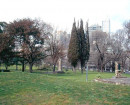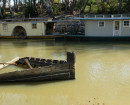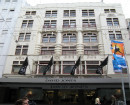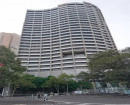WESLEY CHURCH COMPLEX
118-148 LONSDALE STREET AND 117-147 LITTLE LONSDALE STREET MELBOURNE, MELBOURNE CITY
-
Add to tour
You must log in to do that.
-
Share
-
Shortlist place
You must log in to do that.
- Download report
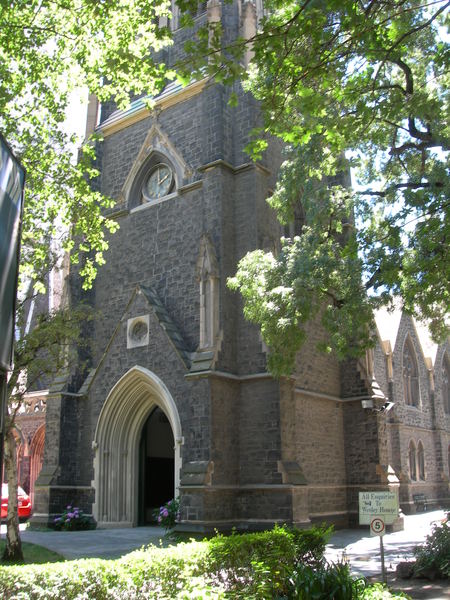

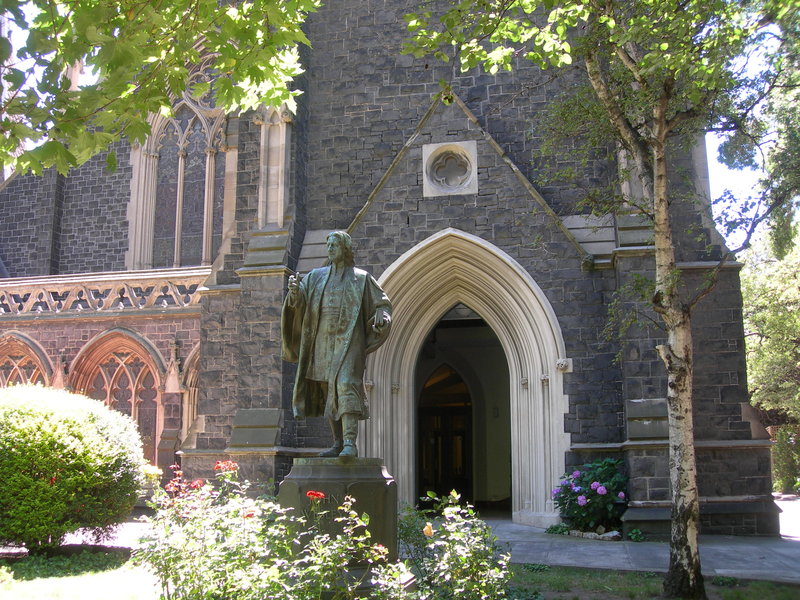


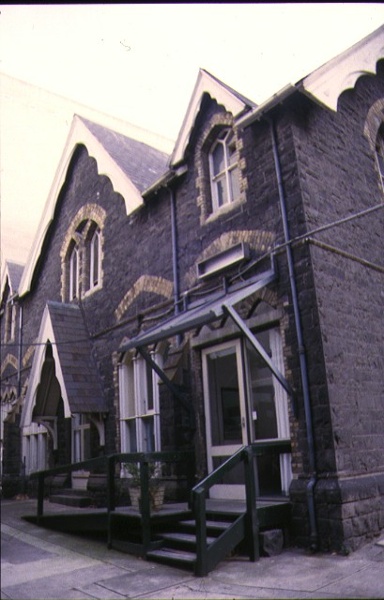
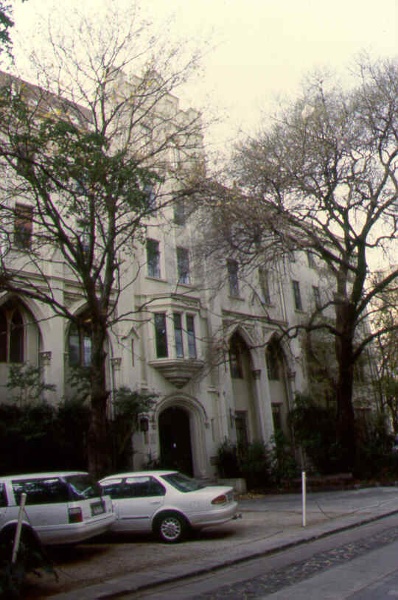


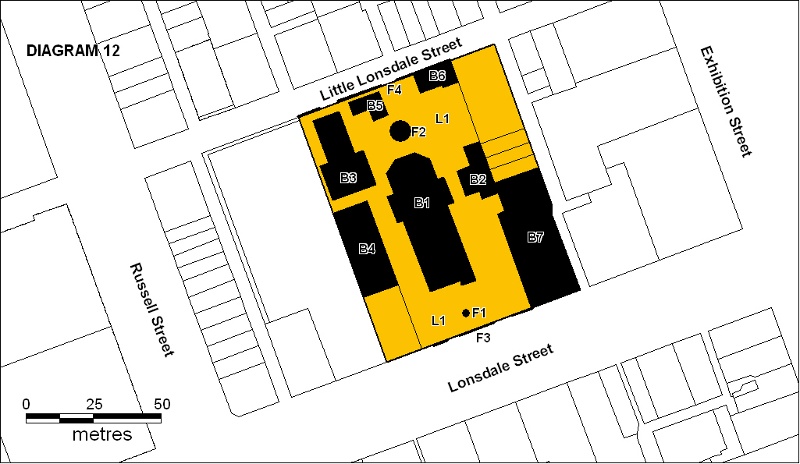
Statement of Significance
What is significant?
The Wesley Church and Wesley Mission Victoria Complex in Lonsdale Street consists of ten buildings including: The Church (1858); The Manse (1859); and The School House (1859) all designed by Joseph Reed; a Caretakers Cottage (1914); the Princess Mary Club (1926), designed by AS Eggleston and Nicholas Hall (1938), designed by Harry Norris. The North Boundary wall along Little Lonsdale St (1869) incorporates remnants of a stables and also includes a section which was rebuilt in 1914 during the construction of the Caretakers Cottage. The Lonsdale Street boundary is defined by a set of basalt central gateposts, the basalt plinths of a cast iron palisade fence and the bases of a smaller set of gates which led to the Manse(1873). Standing in the forecourt of the church is a bronze statue of John Wesley by Paul Montford (1936). The Methodist Church has had a presence in Melbourne since the beginning of European occupation and the Wesley Church has been at this site since 1858 having moved from a site in Collins Street. The Wesley Church complex has been the core of Wesleyan Methodism in Victoria since this time and the headquarters of the Wesley Mission Victoria since 1893.
How is it significant?
The Wesley Church and Wesley Mission Victoria Complex is of historical, architectural and social significance to the State of Victoria.
Why is it significant?
The Wesley Church complex is of architectural and historical significance as a complete and substantial collection of related mid to late nineteenth and early twentieth century ecclesiastical buildings.
The principal group of 1858-59 buildings (Church, School House and Manse) are of architectural significance as the earliest intact church complex in the state. Conceived and completed as a single building project, the 1858-59 buildings are also architecturally significant as an early and essentially intact group of ecclesiastical buildings designed in a correct Gothic Revival Style. This group of buildings is of architectural significance as being the work of noted nineteenth century Melbourne architect Joseph Reed. The School House is of architectural significance as the only known Denominational school in Victoria designed by an architect.
The Wesley church is of architectural significance as an early and highly accomplished example of Gothic Revival styling and for the unusual combination of a gallery on all sides with a cruciform floor plan. The spire is the oldest surviving, and is believed to be the first, spire built in Victoria. The spire is also significant as having been a major landmark in nineteenth century Melbourne.
The Wesley Church is of architectural significance, representing the acceptance of the Gothic Revival style into the mainstream of Wesleyan and other non-conformist churches.
Nicholas Hall is of architectural significance as a fine and intact example of a church hall designed in a Moderne style and as the work of prominent interwar architect Harry Norris.
The Wesley Church complex is of historical significance as a major focus for Methodists in Victoria. The church itself has a symbolic position and prominence in the history of the Wesleyan Methodist Church in Victoria.
The site and complex are of social and historical significance for their long association with various welfare initiatives and programs since the 1850s, in particular those of the Wesley Mission Victoria.
The Wesley Church site is of historical significance for its associations with A M & G R Nicholas, founders of the Nicholas Chemical Manufacturing Company who had a longstanding philanthropic association with the Wesley Church.
The Princess Mary Club is of historical significance in the history of women's employment in Victoria as a rare surviving example of a 1920s hostel for young women coming to the city to work and study, enabling the greater inclusion of women in the workforce.
The School House is of historical significance as a representative example of a nineteenth century denominational school.
The School House is of social significance as housing the offices of the Wesley Mission Victoria when it was established in 1893.
-
-
WESLEY CHURCH COMPLEX - History
There has been a Methodist presence in Melbourne since the beginning of European occupation. A Methodist society was established amongst the immigrants from Tasmania in 1837 and from there the Methodist church in Victoria grew with the establishment of a number of different branches of Methodism with the Wesleyans being in the majority. Initially the Methodist church met briefly in a simple timber building on the corner of Swanston Street and Flinders Lane before moving to a site granted to them on the corner of Collins and Queen Streets in 1840. Services started here with completion of a new stone church in 1847.
The influx of immigrants during the 1850s meant a substantial growth in Victoria’s church congregations and a steep rise in Melbourne’s land prices. To cater for the former the Wesley Church took advantage of the latter by selling their piece of prime real estate in Collins Street for £40,000 in 1857 to undertake the major building program on the current block in Lonsdale Street, which had been granted to them in 1850, and the building of a number of other smaller churches in Melbourne.
A competition was run for the design of the new church in 1857 and this was won by Joseph Reed, who had arrived in Melbourne from Britain in 1853. The foundation stone for the new church was laid in December 1857 and the church was officially opened in on the 26th of August 1858. The organ from the Collins Street church was moved to the new church. The stone courses to the rear of the church have been laid in what could be best described as a capricious fashion, possibly due to the speed in which the church was built.
The Church along with the Wesleyan Church in Fitzroy Street, St Kilda are viewed as being defining moments in the acceptance of the Gothic Revival style into the mainstream of Wesleyan and other non-conformist churches, where previously the style had been viewed with suspicion for its popish associations.
Although incorporated in the original scheme for the complex, the Manse and the School House were not started at the same time as the church but built a year later, but by the same builder as for the church, William Forsyth. They were finished in 1859. The design for the three buildings in the original complex were somewhat altered from the initial design by the time they were built. The Church nave was reduced in length by one bay, the Manse is smaller and set further north on the block than was originally intended and a separate Book Room building that was planned was not constructed but the incorporated into the School House instead.
Apart from functioning as a minister’s residence, the Manse has previously been used for accommodation for the elderly, offices and a coffee shop but now houses the offices of Big Issue magazine, continuing the tradition of the social welfare activities on the site.
The School House was originally built and used as a Denominational day school and is the only known Denominational school in Victoria designed by an architect. (Historic Government Schools, A Comparative Study, June 1993, by Richard Peterson, p.1, Chap. 2 states that “No architect designed Denominational school is known” the study however omits to acknowledge the School House.). It has at various times also been used as a sunday school, a state school, the offices of Lifeline and housed the first offices of the Wesley Central Mission when it was established in 1893.
In 1873 a cast iron fence was built along the Lonsdale Street frontage, incorporating a central gateway leading directly to the church, with two gateways to each side, one leading to the Manse and the other to the School House. The fence was removed in the early 1970s and all that remains is the central gateposts, the basalt plinths of the fence and the bases of the bases of a smaller set of gates which led to the Manse.
A Gothic Revival Conference hall was built in 1888 but this was demolished in 1970 and replaced in 1973 with the current five storey Wesley House. The Caretakers Cottage was built in 1914.
On the 22 February 1902 the church was the site of the unification of the five branches of Methodism in Australia.
In 1926 the Princess Mary Club was constructed as a hostel for young women coming to the city to work and study. This was particularly important as it allowed a safe environment for young women to come to work in the city where previously few such options existed thus affecting the greater inclusion of women in to the work force. Originally the building incorporated a car dealership on the ground floor Lonsdale Street facade. This was later modified to be used as a living room for the hostel in 1940 but was returned to being a shop in the late 1970s.The building underwent substantial modification in 1940-41 and again during the 1970s. These alterations significantly diminished the originally generous communal rooms, converting them to small private cubicles. The Princess Mary Club was the only building in the complex that was built as part of one of the Central Mission’s programs. The land the Club sits on is not part of the original Wesley reserve but was gifted to the Church by A M & G R Nicholas, founders of the Nicholas Chemical Manufacturing Company who also funded the construction of Nicholas Hall.
Nicholas Hall, designed by Harry Norris was built in 1938. It has been used for a variety of purposes including services, meetings and functions. The Hall also incorporates a bio box enabling it to be used for showing films. Nicholas Hall was also used as a temporary polling station for the east Timorese to vote in the East Timor Independence Referendum.To the rear of the site are a number of significant trees including an Olive tree planted in 1875. The tree is supposed to have been brought from Jerusalem by one of Wesley’s followers in 1839. However its location between 1839 and its planting at this site is unknown.
Associated People: Assoc.People DANIEL DRAPER, SIR IRVING BENSON
All of the major churches were concerned about the suitability of Melbourne's boarding and lodging houses for young people coming to the city in search of work in the first decades of the twentieth century. The Catholics, Presbuterians, Methodists, YWCA, Salvation Army and the Church of England Girls' Friendly Society all provided hostel accommodation in the interwar years. The Methodist Church set up the Princess Mary Club in Lonsdale Street in the 1920s as a hostel to give accommodation and moral protection to young single womenfrom the country. In its final years it provided accommodation young Asian students studying in Melbourne. It closed in 1989.
WESLEY CHURCH COMPLEX - Permit Exemptions
General Exemptions:General exemptions apply to all places and objects included in the Victorian Heritage Register (VHR). General exemptions have been designed to allow everyday activities, maintenance and changes to your property, which don’t harm its cultural heritage significance, to proceed without the need to obtain approvals under the Heritage Act 2017.Places of worship: In some circumstances, you can alter a place of worship to accommodate religious practices without a permit, but you must notify the Executive Director of Heritage Victoria before you start the works or activities at least 20 business days before the works or activities are to commence.Subdivision/consolidation: Permit exemptions exist for some subdivisions and consolidations. If the subdivision or consolidation is in accordance with a planning permit granted under Part 4 of the Planning and Environment Act 1987 and the application for the planning permit was referred to the Executive Director of Heritage Victoria as a determining referral authority, a permit is not required.Specific exemptions may also apply to your registered place or object. If applicable, these are listed below. Specific exemptions are tailored to the conservation and management needs of an individual registered place or object and set out works and activities that are exempt from the requirements of a permit. Specific exemptions prevail if they conflict with general exemptions. Find out more about heritage permit exemptions here.Specific Exemptions:General Conditions: 1.
All exempted alterations are to be planned and carried out in a manner which prevents damage to the fabric of the registered place or object. General Conditions: 2.
Should it become apparent during further inspection or the carrying out of works that original or previously hidden or inaccessible details of the place or object are revealed which relate to the significance of the place or object, then the exemption covering such works shall cease and the Executive Director shall be notified as soon as possible. Note: All archaeological places have the potential to contain significant sub-surface artefacts and other remains. In most cases it will be necessary to obtain approval from Heritage Victoria before the undertaking any works that have a significant sub-surface component. General Conditions: 3.
If there is a conservation policy and plan approved by the Executive Director, all works shall be in accordance with it. Note: The existence of a Conservation Management Plan or a Heritage Action Plan endorsed by Heritage Victoria provides guidance for the management of the heritage values associated with the site. It may not be necessary to obtain a heritage permit for certain works specified in the management plan. General Conditions: 4.
Nothing in this declaration prevents the Executive Director from amending or rescinding all or any of the permit exemptions. General Conditions: 5.
Nothing in this declaration exempts owners or their agents from the responsibility to seek relevant planning or building permits from the responsible authorities where applicable. Regular Site Maintenance :
The following site maintenance works are permit exempt under section 66 of the Heritage Act 1995, a) regular site maintenance provided the works do not involve the removal or destruction of any significant above-ground features or sub-surface archaeological artefacts or deposits; b) the maintenance of an item to retain its conditions or operation without the removal of or damage to the existing fabric or the introduction of new materials; c) cleaning including the removal of surface deposits, organic growths, or graffiti by the use of low pressure water and natural detergents and mild brushing and scrubbing; d) repairs, conservation and maintenance to plaques, memorials, roads and paths, fences and gates and drainage and irrigation. e) the replacement of existing services such as cabling, plumbing, wiring and fire services that uses existing routes, conduits or voids, and does not involve damage to or the removal of significant fabric. Note: Surface patina which has developed on the fabric may be an important part of the item’s significance and if so needs to be preserved during maintenance and cleaning. Note: Any new materials used for repair must not exacerbate the decay of existing fabric due to chemical incompatibility, obscure existing fabric or limit access to existing fabric for future maintenance. Repair must maximise protection and retention of fabric and include the conservation of existing details or elements. Fire Suppression Duties :
The following fire suppression duties are permit exempt under section 66 of the Heritage Act 1995, a) Fire suppression and fire fighting duties provided the works do not involve the removal or destruction of any significant above-ground features or sub-surface archaeological artefacts or deposits; b) Fire suppression activities such as fuel reduction burns, and fire control line construction, provided all significant historical and archaeological features are appropriately recognised and protected; Note: Fire management authorities should be aware of the location, extent and significance of historical and archaeological places when developing fire suppression and fire fighting strategies. The importance of places listed in the Heritage Register must be considered when strategies for fire suppression and management are being developed. Weed and Vermin Control :
The following weed and vermin control activities are permit exempt under section 66 of the Heritage Act 1995, a) Weed and vermin control activities provided the works do not involve the removal or destruction of any significant above-ground features or sub-surface archaeological artefacts or deposits; Note: Particular care must be taken with weed and vermin control works where such activities may have a detrimental affect on the significant fabric of a place. Such works may include the removal of ivy, moss or lichen from an historic structure or feature, or the removal of burrows from a site that has archaeological values. Landscape Maintenance :
The following landscape maintenance works are permit exempt under section 66 of the Heritage Act 1995, a) landscape maintenance works provided the activities do not involve the removal or destruction of any significant above-ground features or sub-surface archaeological artefacts or deposits; b) watering, mowing, top-dressing and fertilising necessary for the continued health of plants, without damage or major alterations to layout, contours, plant species or other significant landscape features; c) pruning to control size, improve shape, flowering or fruiting and the removal of diseased, dead or dangerous material, not exceeding 20% of the crown of the tree within a period of two years; d) tree surgery by a qualified horticulturalist or tree surgeon necessary for the health of those plants. Public Safety and Security :
The following public safety and security activities are permit exempt under section 66 of the Heritage Act 1995, a) public safety and security activities provided the works do not involve the removal or destruction of any significant above-ground structures or sub-surface archaeological artefacts or deposits; b) the erection of temporary security fencing, scaffolding, hoardings or surveillance systems to prevent unauthorised access or secure public safety which will not adversely affect significant fabric of the place including archaeological features; c) development including emergency stabilisation necessary to secure safety where a site feature has been irreparably damaged or destabilised and represents a safety risk to its users or the public. Note: Urgent or emergency site works are to be undertaken by an appropriately qualified specialist such as a structural engineer, or other heritage professional. Signage and Site Interpretation :
The following Signage and Site Interpretation activities are permit exempt under section 66 of the Heritage Act 1995, a) signage and site interpretation activities provided the works do not involve the removal or destruction of any significant above-ground structures or sub-surface archaeological artefacts or deposits; b) the erection of non-illuminated signage for the purpose of ensuring public safety or to assist in the interpretation of the heritage significance of the place or object and which will not adversely affect significant fabric including landscape or archaeological features of the place or obstruct significant views of and from heritage values or items; c) signage and site interpretation products must be located and be of a suitable size so as not to obscure or damage significant fabric of the place; d) signage and site interpretation products must be able to be later removed without causing damage to the significant fabric of the place; Note: The development of signage and site interpretation products must be consistent in the use of format, text, logos, themes and other display materials. Note: Where possible, the signage and interpretation material should be consistent with other schemes developed on similar or associated sites. It may be necessary to consult with land managers and other stakeholders concerning existing schemes and strategies for signage and site interpretation. Minor Works : Note:
Any Minor Works that in the opinion of the Executive Director will not adversely affect the heritage significance of the place may be exempt from the permit requirements of the Heritage Act. A person proposing to undertake minor works may submit a proposal to the Executive Director. If the Executive Director is satisfied that the proposed works will not adversely affect the heritage values of the site, the applicant may be exempted from the requirement to obtain a heritage permit. If an applicant is uncertain whether a heritage permit is required, it is recommended that the permits co-ordinator be contacted.The following works are also permit exempt:
Removal but not replacement of additional brickwork from the underside of external stairs to School House.
Removal but not replacement of masonite from the first floor ceiling of the School House.
Removal but not replacement of partition walls from the interior of the ground floor of the School House.
Removal but not replacement of timber fencing to the exterior of the Manse.
Removal but not replacement of extraneous items such as air conditioners, pipe work, ducting, wiring, antennae, aerials etc, and making good.
Alterations to the seating configuration in the church.
All works including demolition and internal modification but not additions to the brick addition from the rear of the Manse.
Alteration and modification to the interior of the Princess Mary Club including demolition of existing walls and removal of fittings and fixtures.
All works including demolition and internal modification but not additions to Wesley House.
All works including demolition and internal modification but not additions to brick structure between the Schoolhouse and the brick wall to Little Lonsdale Street in the north west corner of the site.
All works including demolition and internal modification but not additions to the brick structure in the north east corner of the site.WESLEY CHURCH COMPLEX - Permit Exemption Policy
The significance of the Wesley Church complex lies in the level of intactness of the buildings, their architectural merit and their physical and material relationship to each other. Whilst recognising the significance of the ongoing social welfare activities of the church and the mission, it is essential that the important architectural fabric of the site be maintained. Any alteration or addition to the structure and fabric of the architecturally significant elements of this place may greatly diminish their significance and diminish the understanding of them.
There are a number of structures on this site that have no cultural significance and as such can be removed without diminishing the cultural significance of the place. These include Wesley House, later additions to the Manse and the brick structure in the northwest corner of the site. The brick structure located near the north east corner of the site, whilst it could be removed without detriment to the cultural significance of the site, is closely located to the 1869 brick wall and remnants of the 1869 stables. To ensure that any alteration or demolition of this structure does not adversely affect the wall or the remnants of the stables any proposed works to it or demolition of it will require a permit.
Because of the intensity and the nature of the occupation of the site, as well and the previous history of building activity associated with it, the site is currently listed in the Victorian Heritage Inventory for its archaeological potential. The site has the archeologically potential to illustrate important evidence related to these earlier periods of occupation. As such approval will be required for any works that involve below ground level disturbance.
-
-
-
-
-
FORMER CARLTON AND UNITED BREWERY
 Victorian Heritage Register H0024
Victorian Heritage Register H0024 -
ROSAVILLE
 Victorian Heritage Register H0408
Victorian Heritage Register H0408 -
MEDLEY HALL
 Victorian Heritage Register H0409
Victorian Heritage Register H0409
-
'Altona' Homestead (Formerly 'Laverton' Homestead) and Logan Reserve
 Hobsons Bay City
Hobsons Bay City
-
-






